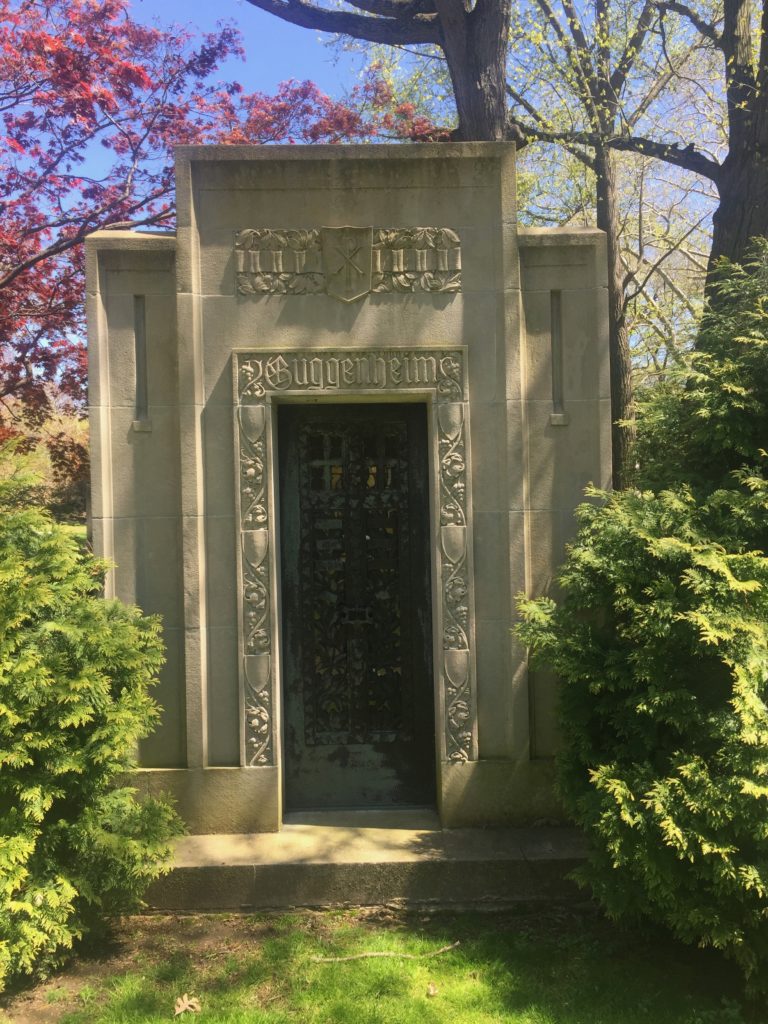Erik Visits an American Grave, Part 600
This is the grave of Simon Guggenheim.

Born in 1867 in Philadelphia, Simon Guggenheim grew up in the lap of luxury. His father Meyer was one of the richest men in America, making his fortune in the import-export business and then expanding into mining. Due to that, Guggenheim moved out to Pueblo, Colorado as a young man, working for his father as an ore buyer for the company. Never having to worry about money, Guggenheim devoted himself primarily to charity works. When he married in Manhattan at 1898, yes the wedding was extremely lavish. But he also put on a Thanksgiving dinner for 5,000 poor children. Of course his interests here never moved beyond personal charity to structural change, but it was the Gilded Age after all. He and his wife Olga Hirsch, the daughter of a big New York realtor, moved to Denver. When their first child was born, they gave a bunch of money to the Colorado School of Mines for a new building as a gift, named after himself of course. He became a big donor across Colorado.
Due to this, Guggenheim was elected to the Senate in 1907, as a Republican of course. A lot of people believed that he simply bought his seat and this is true enough, though also infused with anti-Semitism. Colorado was a state where Populism was a powerful force and even though that had waned by 1907 as a political movement, the general beliefs were still there that were more anti-rich than anti-Semitic, but which could easily be combined, especially when the senator is a rich Jewish man in the state. He had wanted to run for office for awhile before this. Being in Colorado, he adopted silver as his mantra, making him the rare silver Republican. This really, really, really annoyed his family and investors in New York, who were of course goldbugs all the way. But Guggenheim felt himself somewhat inferior to his family members and wanted to stand out and running for office on a somewhat incongruous platform was one way to do that, especially in an era when most elites simply bought their politicians instead of bothering with holding office themselves. His Senate run was not well-thought of in Colorado. One newspaper in Denver called him “Napoleon Bonaparte without a brain.” It was people like Guggenheim and William Clark that led to the 17th Amendment, creating direct elections of senators.
Guggenheim was a rather indifferent senator. After all, he was just a rich guy masquerading as a politician. He was interested in the Philippines and wanted to establish a University of the United States, the kind of national project that people who believed in American development through education had argued for going back to at least John Quincy Adams. He also turned his back on the talk about Populism that had helped him win the office. He became known as the single most conservative man in the Senate, which is quite the bar in this era. He became a huge opponent of any bills to reduce workers’ hours, for instance. He did however support the 17th Amendment, even though he was part of the reason for its existence. He served one term and decided not to run for reelection in 1913.
He and Olga moved to New York, where he managed some of the family assets. From 1919 to 1941, he was president of the American Smelting and Refining Company, or ASARCO, one of the most vile polluting corporations in all of American history. His later years were filled with tragedy. His oldest son died of mastoiditis, basically a brain infection, in 1922, just as he was leaving for college. And then his second son committed suicide in 1932. It was to honor their two sons that Simon and Olga created the Guggenheim Foundation, named specifically after their first son. This is unquestionably the man’s greatest legacy to the nation, much more so than his awful term in the Senate. Guggenheim himself died in 1941. He was 73 years old. Olga lived all the way until 1970. She became a major patron of modern art for the rest of her long life.
Simon and Olga Guggenheim are buried in Woodlawn Cemetery, Bronx, New York.
If you would like this series to visit other members of the Guggenheim clan, you can donate to cover the required expenses here. Plus it’s the 600th post in the series, a milestone of sorts! So let’s go for 600 more posts! Meyer Guggenheim is in Brooklyn, as is his older brother and fellow mining capitalist Daniel. Previous posts in this series are archived here.


